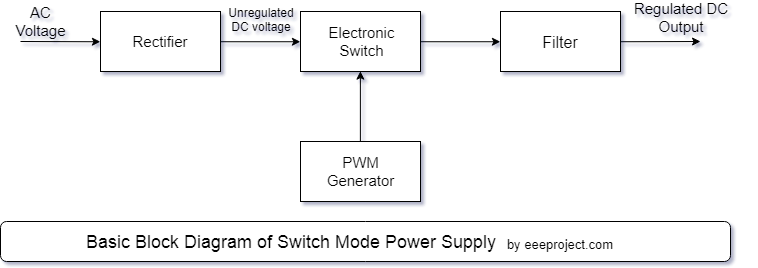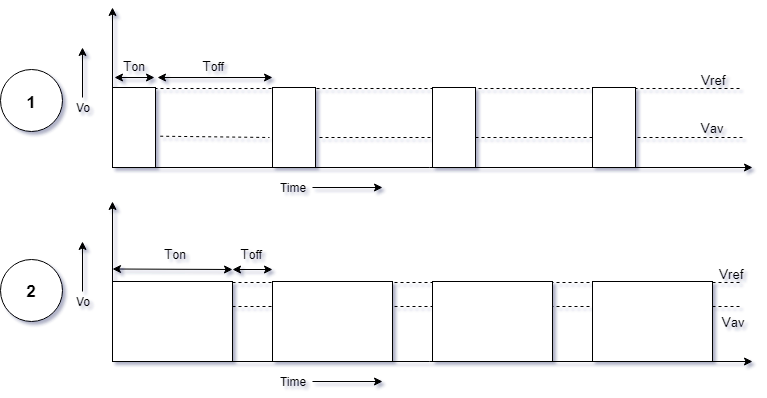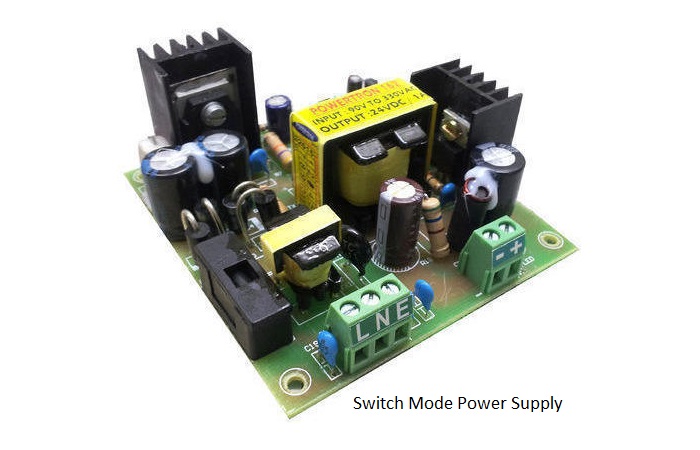What is Switch Mode Power Supply
There are many types of Switch Mode Power Supply which we can see in different Applications.
But how to define it ?
The Switch Mode Power Supply is a device which converts the AC or DC voltage into a regulated DC voltage.

In the above block diagram we can very easily understand the basic working of Switch Mode Power Supply.
You can see many other block representation but the above is the most basic diagram which illustrates the general working of SMPS.
There are four main components in Switch Mode Power Supply which are,
- Rectifier
- Electronic Switch
- PWM Generator
- Filter
The Rectifier in SMPS is a full wave rectifier which converts the AC voltage into unregulated DC voltage.
The Electronic Switch is another type of switch used in SMPS as a high frequency switch. Using the high frequency switch ads up the advantage to the circuit. The lesser electronic components are used the size of the electronic circuit will be reduced.
The PWM Generator generates the Pulse Width Modulation signal. The PWM generator allows the electronic switch to pass the unregulated dc voltage from the rectifier.
The Pulse width modulator allows us to regulate the output voltage. With the help of PWM generator we can get the desired output DC voltage.
The Filter circuit is used to regulate the output voltage of the Switch Mode Power Supply in order to get the pure constant dc voltage.
Basic working of Switch Mode Power Supply

Above is the output waveform of the Switch Mode Power Supply.
Vav = Average DC output voltage.
Vref = Reference voltage.
Ton = Time for which the switch is on.
Toff = Time for which the switch is off.
The reference voltage Vref is the unregulated output voltage of the rectifier which is supplied to the electronic switch.
The Average DC output voltage Vav is actual output voltage which we get from switch mode power supply device.
We can control the average DC output voltage by controlling the pulse width of the PWM.
Ton is the time period in which the switch is on and the output voltage is maximum. Toff is the time period in which the switch is off the output voltage is zero.
Now calculating the Average DC output voltage (Vav).
Vav = Vref x [ Ton / (Ton + Toff) ]
Also,
D (Duty cycle) = Ton / (Ton + Toff)
Hence,
Vav = Vref x D
Or
Average DC output voltage = Reference Voltage x Duty Cycle
Controlling the Average output voltage of Switch Mode Power Supply
We know that we can control the duty cycle by controlling the Ton that is by controlling the width of the PWM signal.
In order to understand it, you have to head back to the output waveform of the Switch Mode Power Supply.
Case 1: There is some input reference voltage and so there is an average output voltage.
Case 2: The pulse width of Ton is increased which causes to increase in the duty cycle.
As the previous expression, it is confirmed that the Average output voltage of SMPS is directly proportional to the duty cycle as well as a reference voltage.
So, the increase in Pulse width Ton will cause the duty cycle to increases and eventually increases the Average DC output voltage of the Switch Mode Power Supply.


1 thought on “Switch Mode Power Supply: Working and Application”
I would like to get a complete explanation of Switched Mode Power Supply systems.
With regards,